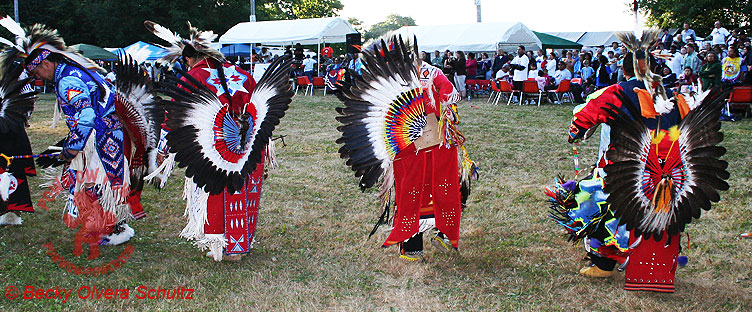Native American Powwow History-4
Native American Powwow History, Page 4
The powwow’s main focus is on dance, drum and song, but other activities include honoring ceremonies, games, food, arts and crafts and more importantly, the opportunity to see old friends and make new ones. Powwows are open to the public, so the venue provides interaction between the native and non native.
In addition to the celebration of culture, the main attraction for participants is socializing; a time to get together, return home, exchange gossip and court (Highwater 1977:31). The powwow is also an environment where traditions like honesty and generosity are kept alive and passed on from generation to generation (Ancona 1993:42). Jonathon Windy Boy (Chippewa-Cree), Grass dancer, “Traditionally a powwow celebration was expressed through song and dance. However, a significant and often forgotten part of these get-togethers was the exchange of gifts. This practice was an important part of reestablishing old ties and friendships with each other. When a gift was given, proper etiquette required that a gift be given in return. Throughout the years the powwow has evolved into a tradition exemplifying generosity
and giving (Roberts 1992:22).”
Faced with continual change in the American society, powwow celebrations help to maintain some continuity of traditions. Often visitors to powwows are disappointed because of the “modern” aspects of the powwow like sound systems, big lights, paper numbers pinned to dancers, tape recorders. Despite this modern paraphernalia, the powwow is carrying out a long heritage in the now as well as into the future (Parfit 1994:6:104-5,113). The editor of Canada’s main Indian magazine, Windspeaker, stated, “The ‘gathering’ aspect of powwows is significant. Time and again dancers and spectators tell us that things they like best about dancing or visiting at powwows is the people they meet and the friends they make. Powwows break down the barriers and unify all who take part. Whether you’re from the southernmost regions of the United States or far northern Canada-common ground is found at a powwow. Today the celebration aspect of powwows is as important as a hundred years ago when the dancers celebrated a successful hunt or victorious war party. But now, the celebration is of being Indian. Of having a unique culture and long reaching history. Of letting the spirit fly with the beat of the drum (Roberts 1992:9).”
Originally dances were performed on occasions like before warriors left for hunting, raiding, battle or when they returned to celebrate success. Dances were also performed for religious ceremonies as well as to honor or initiate members of different tribal groups, called societies. In this last century, however, Indians from many different groups come together to celebrate and reaffirm their heritage and traditions at powwows, putting differences aside. The old war-society dances have evolve to become a general dance style, while other styles have been rediscovered to develop into the main four styles of dancing experienced at today’s powwows: Traditional, Fancy, Grass and Jingle-dress (Ancona 1993:3
It is interesting to note, that according to Boye Ladd (Fancy & Exhibition dancer), “Women started coming out onto the dance floor and accepted into dance circles around 1953-4. They were never permitted on the dance floor before that time. They’d stand in the background, usually behind the drums, and sing (Roberts 1992:52).”



